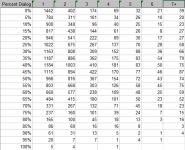8letters
Writing
- Joined
- May 27, 2013
- Posts
- 2,257
I went through 32,229 stories from 8/30/2023 to 3/26/24 and looked at how many paragraphs in the story contained dialogue. I defined "contained dialogue" as having a double quote ("). Yes, I know some writers use single quotes instead of double quotes to enclose dialogue, but hopefully that is a very small percentage of the stories.
As usual, page length is the biggest driver of rating. Here's the average rating by page length and percentage of paragraphs that contain dialog:

30% to 70% seems to be the sweet spot, with a drop off when the story is out of that range. The longer the story, the less significant the effect.
Edit: Adding story counts

35-45% dialog is the peak of the distribution, with things falling off on either side.
As usual, page length is the biggest driver of rating. Here's the average rating by page length and percentage of paragraphs that contain dialog:

30% to 70% seems to be the sweet spot, with a drop off when the story is out of that range. The longer the story, the less significant the effect.
Edit: Adding story counts

35-45% dialog is the peak of the distribution, with things falling off on either side.
Last edited: